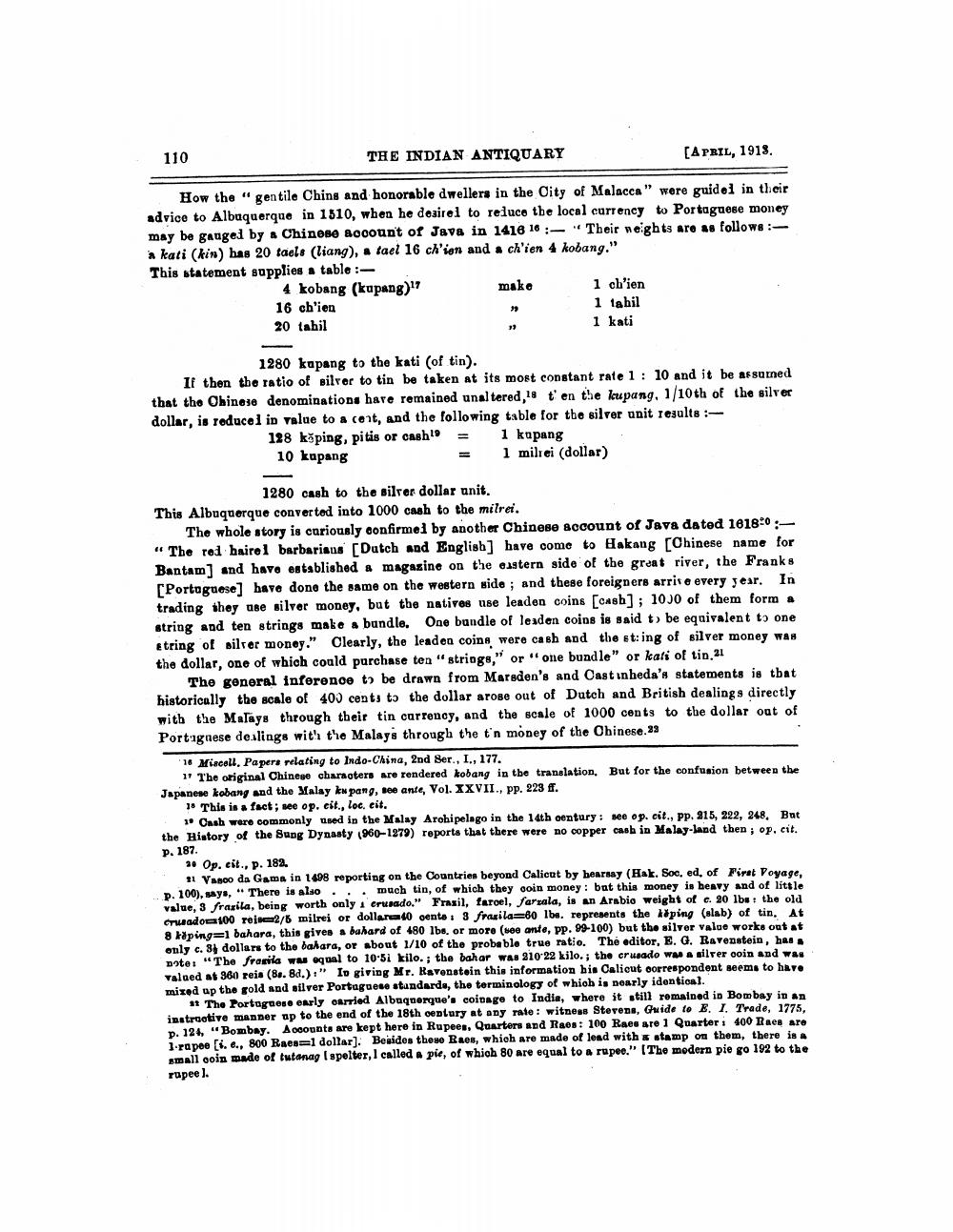________________
110
THE INDIAN ANTIQUARY
[APRIL, 1918.
How the "gentile China and honorable dwellers in the City of Malacca" were guidel in their advice to Albuquerque in 1310, when he desire to reluce the local currency to Portaguese money may be gauged by a Chinese account of Java in 1416 16 :- "Their weights are as follows: in kati (kin) has 20 taels (liang), a tael 16 ch'ion and a ch'ien 4 kobang." This statement supplies a table : 4 kobang (kapang)?
make
1 ch'ien 16 ch'ien
1 tahil 20 tahil
1 kati
1280 kupang to the kati (of tin). If then the ratio of silver to tin be taken at its most constant rate 1 : 10 and it be assured that the Obinese denominations have remained unaltered, 18 t'en the leupang, 1/10th of the silver dollar, is reducel in value to a cent, and the following table for the silver unit results
128 kõping, pitis or cash' = 1 kupang 10 kapang
= 1 miliei (dollar)
1280 cash to the silver dollar anit. This Albuquerque converted into 1000 cash to the milrei.
The whole story is curiously confirmed by another Chinese account of Java dated 181890:" The red hairol barbarimus [Dutch and English] have come to Hakang [Chinese name for Bantam] and have established a magazine on the eastern side of the great river, the Franks [Portuguese] have done the same on the western side ; and these foreigners arrive every year. In trading shey use silver money, but the natives use leaden coins (cash) ; 1000 of them forma string and ten strings make a bundle. One bundle of leaden coins is said to be equivalent to one string of silver money." Clearly, the leadea coins were cash and the et:ing of silver money was the dollar, one of which could purchase ten "strings," or "one bundle" or kali of tin.21
The general inference to be drawn from Marsden's and Castın heda's statements is that historically the scale of 400 cents to the dollar arobe out of Dutch and British deslings directly with the Malays through their tin currency, and the scale of 1000 cents to the dollar out of Portugaese dealings with the Malays through the t'n money of the Chinese 32
16 Miscell, Papers relating to Indo-China, 2nd Ser., I., 177.
11 The original Chinese characters are rendered kobang in the translation. But for the confusion between the Japanese kobang and the Malay knpang, see ante, Vol. XXVII., PP. 223 f.
10 This is a fact, see op. cit., loc. cit.
** Cash were commonly used in the Malay Arohipelago in the 14th century: see op. cit., pp. 215, 222, 248, Bat the History of the Sung Dynasty 1960-1979) reports that there were no copper cash in Malay-land then; op. cit. P. 187.
2. Op. cit., p. 182.
11 Vasco da Gama in 1498 reporting on the Countries beyond Calicut by bearsay (Hak. Soc, ed, of Firat Poyage, p. 100), says, "There is also... much tin, of which they coin money: but this money is heavy and of little
Nue. 3 frazila, being worth only crusado." Frasil, taroel, farzala, is an Arabia weight of c. 24 cuadora 100 reise2/6 milrei or dollara gente : 3 frasila=80 lbs. represents the kòping (slab) of tin. At 8 Höping=] bahara, this gives a bahard of 480 lbs, or more (noe ante, PP. 99-100) but the silver valoe works out at only c. dollars to the bahara, or about 1/10 of the probable true ratio. The editor, E. G. Ravenstein, has. Date: "The framvia ww equal to 10-51 kilo.; the bahar was 210-22 kilo.; the crusado www a silver coin and was valued at 380 reis (B.. Bd.)." Iv giving Mr. Ravenstein this information his Calicut correspondent seems to have mixed up the gold and silver Portagiese standarde, the terminology of whiob is nearly identical.
* The Portuguese early carried Albuquerque's coidage to India, where it still remained in Bombay in an instructive manner up to the end of the 18th oeptury at any rate : witness Stevens, Guide to B. I. Trade, 1775, p. 124, "Bombay. Accounts are kept here in Rupees, Quarters and Raos: 100 Raes are 1 Quarter i 100 Raes are 1-rapee (i. e., 800 Raes=1 dollar). Besides these Raes, which are made of lead with a stamp on them, there is a small coin made of tutanag I spelter, I called a pie, of which 80 are equal to a repee." (The modern pie go 192 to the rupeel.




